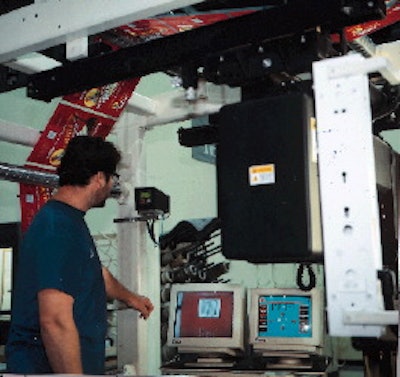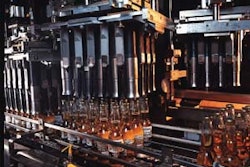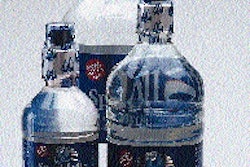In an age where some businesses allocate considerable finances to hire corporate identity firms, Sun*Maid® sports one of the most recognizable logos to appear on retail store shelves. The wholesome image shows a girl in a red bonnet holding a basket brimming with grapes, beneath a bright yellow sun. Not so recognizable, at least to consumers, are the exacting printing requirements necessary to achieve that image. While they proved too daunting for one converter, these tough print tolerances are being met consistently by flexible packaging manufacturer Duralam (Appleton, WI). The Sun*Maid image is printed flexographically in eight colors on a Vision(TM) press made by Paper Converting Machine Co. (Green Bay, WI). PCMC sales engineer Mike Reedy says Duralam was one of the first companies to use the press, which accommodates film to 28" wide, with 10" to 24" continuous repeat lengths. Duralam purchased the machine in mid-'95 to accommodate short-run, narrow-web jobs like the Sun*Maid structures. That was shortly after Forest Park, IL, confectioner Ferrara Pan Candy Company added Sun*Maid Chocolate Covered Raisins and Planters® Milk Chocolate Covered Peanuts to its product line, via licensing agreements with Sun*Maid and Nabisco Brands, respectively. As a result, FP manufactures, packages and sells these sweets to retailers nationwide. Enhanced color quality Once the licensing agreements were completed, Ferrara Pan turned to one of its regular converters to produce the film used to make bags for these candies. "That converter printed the job in six colors, with 80- to 95-line screen," notes Philip Tencate, Ferrara Pan's director of packaging. "That just wasn't good enough for the color demands of the Sun*Maid film, though," Tencate says. "We were looking to improve the print quality." So Ferrara Pan contacted Duralam, a converter it had used in the past. "The main advantages Duralam provided were eight-color printing, with a 120-line screen," he states. In 18 months, Duralam's investment in the Vision press has proven to be a wise one. "The press helps us with short-run jobs in that we make press changeovers quickly and maximize our uptime for narrow-web runs," says Dan Baird, the converter's vp of sales. By maximizing uptime, Baird estimates Duralam, "has increased productivity on short-run jobs by 60 percent, which is considerably more than we anticipated." According to Mark Krueger, a process engineer with Duralam, the Vision press, "is our first and only narrow-web press. Before adding the press, we printed shorter-run jobs on a wide web press, so they were really short runs." The cost of lengthy makeready time on the wide-web press, and associated material waste, helped Duralam justify the investment in the Vision press. Duralam is also enthused by the added business the press has helped bring in. "We haven't actively gone out with the sole purpose of acquiring additional sales for this machine," Baird says, "but it has helped us become more competitive in the short-run market. We've also been able to move jobs around within our plant so that we can better utilize the abilities of the Vision press. As a result, the press is running jobs that we had run on other presses, thus freeing them to handle longer runs." Short-run mindset The PCMC Vision press prints three Sun*Maid bag structures: a 1.4-oz vend-pack, 7-oz hole-punched bag sold on a display peg, and a 2-lb laydown "value" bag. The latter material was being printed at the time of Packaging World's visit. "We're constantly looking at our market, but a few years ago we did some extensive research into the direction our business was going, and we realized that about half the jobs we produced were for short runs," Baird explains. "When PCMC came out with this narrow-web press, we saw an opportunity to take advantage of what we do well. The machine fits our market niche to a 'T,'" he says. "The real issue for us in focusing on short-run jobs," Baird continues, "is reducing makeready time because that's where you accumulate labor and downtime costs. We average about seven jobs on the press in a day, with each job about 4ꯠ-feet-long." That makes changeover and uptime the highest priority, not printing speed, even though the narrow-web Vision press is capable of speeds in the 800-fpm range. "We run the machine at just over 400 feet-per-minute," Baird notes. "We've learned that the higher speeds are good if you're running an all-day-type job, but we don't have too many of those. "What benefit is there to running 800 feet-per-minute for such a short period of time?" he asks rhetorically. "That little bit of extra time you save isn't worth [the risk of a printing error on] the high-quality work we do on the Vision press." No-tool changeover A complete changeover on the press can be accomplished by two people in about an hour, without tools, Krueger says. During a 24-hour period, Krueger says this is done about seven times on average. However, some short-run jobs require less-extensive changeovers, allowing Duralam even greater flexibility. "We've done as many as 12 or 14 changeovers in a day," Krueger says, "for extremely short jobs such as private-label runs." To do a complete changeover, operators must remove and clean ink chambers and pumps, anilox and plate rolls, gearing, as well as the film substrate. Once these tasks are accomplished, new ink, film, plates, rolls, gearing, etc., must be replaced for the subsequent print run. "Because of its smaller size, this press can be set up and cleaned up quickly compared to a wider web," Baird elaborates. "It's more accessible, and the cylinders it uses are relatively light [about 35 lb] compared to a wide-web press where cylinders can weigh up to 1귔 pounds." Color challenges Printing the Sun*Maid film is an excellent example of the press's ability to deliver short-run print jobs. Printing is done on Bicor® LBW oriented polypropylene film from Mobil Chemical, Films Div. (Pittsford, NY). For the 1.4-oz vend-pack and the 2-lb bag, 100-ga film is used; 75-ga for the 7-oz bag. "We use the LBW film because it doesn't tack down to the back finseal on our vertical form/fill/seal equipment," explains Ferrara Pan's Tencate. "We use a slightly thicker OPP structure for the larger size because the film provides additional strength, and for the vend-pack because it helps the bag stand up in the vending machine, and gives it more stiffness to withstand the drop within the machine when it's purchased." "The Sun*Maid job is challenging," asserts Krueger. "The girl in the logo is especially complex. Her blouse has a bluish cast that requires blue and red dots. We couldn't use just a straight blue. We had to make sure the blue dots were larger than the red, without eliminating the red." Achieving the proper facial tones, Baird says, "presented tremendous challenges." "For facial tones, we're normally in the 600-line anilox roll range," says Krueger. "We use 800-line anilox rolls on the Vision press to print a finer dot pattern. At first there was too much magenta in this area. We redid graphics three times and discussed this with the people at Ferrara Pan and Sun*Maid to achieve the facial tones they required. "An even bigger challenge," Krueger points out, "was the detail work in the eyes. As small as the eyes are, we need to maintain a little white to both sides of each iris to make the eyes look natural. We removed color dots in those two areas so the white would show. This way, when the consumer sees it, he or she would say, 'hey, that bag really looks sharp.'" Another challenge was to make sure the chocolate-covered raisins printed next to the window on the 1.4-oz and 2-lb bags would look just like the real product that would be visible through the window when the pack was filled. "With this press we were able to match Ferrara Pan's and Sun*Maid's standards," Krueger says. Run efficiency To run the job, an operator loads a roll of unprinted OPP film onto the Vision press's cantilevered unwind. Unlike some conventional unwinds where the roll of film and core have to be hoisted simultaneously into position, the core shaft is permanently mounted to one side of the unwind so that the operator merely has to slide the roll onto the extended shaft. Servo motors are positioned at the unwind, printing section, and rewind to move film through the Vision press. Tension is controlled by dancer bars. An edge guide system guides film through the unwind, printing and rewind sections of the press. From the unwind, film moves to the first of eight stations on the rotary press. The printing process is identical at each station. A rubber nip roll holds the film down to the 60" central impression cylinder drum, which provides the flat surface necessary for printing. Each of the eight stations includes a pump that delivers ink to a doctor blade chamber. Each chamber floods a rotating anilox roll, with a doctor blade at one end of the roll. The blade scrapes off the ink, while a containment blade at the opposite end rides against the anilox roll to contain the ink within the chamber and prevent spilling. The anilox roll transfers ink to the image on the plate, which is mounted to a revolving plate cylinder. The image is pressed onto the film which contacts the central impression cylinder drum. Once the first ink laydown is complete, a dryer blows hot air onto the film. Temperatures are approximately 225° F. This process is repeated for each color. After the eighth color is applied, the film proceeds through a 12-foot-long tunnel dryer where 250°F temperatures completely dry the inks. To cool the film back down to ambient temperatures for rewinding, the material passes between two 10" chill rolls. Dual inspectors Just before the film rewinds, operators can visually inspect the film's print quality in two ways. One is via a video monitor that displays a picture of the printed film, as provided by a camera mounted just above the film at the top of the press. The camera traverses the width of the film web, providing a view that measures approximately 3" W x 5" L. The second inspection device is a web scanner that allows an operator to view the complete cross-section of the web through a viewing area. The scanner includes a rotating set of mirrors that visually stop the action of the film momentarily, enabling the operator to view any area across the width of the material. By using these two inspection devices, an experienced press operator like Duralam's John Merbach can use a rotary dial to make register and impression adjustments to the press. Modified laminator The servo-driven rewind permits automatic splicing on the fly. The printed film rewinds and is transferred to a laminator that Duralam rebuilt specifically to accommodate narrow-web press runs. "We spent considerable time modifying drives and tensions on the laminator," explains Baird. "We put a drive on the unwind so that we could control film tension better," adds Krueger. "And we added lightweight rollers. The lighter the rollers the less inertia it takes to start the film through the machine. Krueger says the problem with PP film during lamination is that it "has a tendency to snap back as it's pulled through the machine. That tends to make your repeat lengths inconsistent. There are eye markers required on packaging machines and if the distance between these markers is inconsistent, it will be almost impossible to run the film on the form/fill/seal equipment." Also, running narrow-web film on a wide-web laminator, he says, "could cause the web to neck in a bit." The modified machine adhesive-laminates the printed OPP structure to an inner sealant layer of linear low-density polyethylene film. Ferrara Pan uses 1.25 mil for the 1.4-oz bag, 1.5 mil for the 7-oz size, and 1.75 mil for the 2-lb version. The LLDPE film is supplied by both Deerfield Plastics (South Deerfield, MA), and Duralam. Customer satisfaction Tencate tells PW that Ferrara Pan may soon make a change on the 1.4-oz bag material. "During vertical form, fill, and sealing, the heat from sealing can cause some of the chocolate to melt, especially on a package as short as that of our vend-pack. If chocolate melts, that would be visible through the window in the package. That's not the image we want to convey. To prevent that, we'll probably go to a polypropylene sealant film, in the 80- to 100-gauge range." The finished structure is brought to a Titan Converting Equipment (Cumming, GA) slitter/rewinder, purchased this past summer. Web widths are 7" for the 1.4-oz size; 105/8" for the 7-oz pack, and 16" for the 2-lb bag. Ferrara Pan vertically forms, fills and seals bags with product at speeds ranging between 120 and 135 bags/minute, depending on size. "Since we had worked with Duralam before, we knew their capabilities, and the Vision narrow-web press produces printing that meets the requirements of Ferrara Pan and Sun*Maid," concludes FP's Tencate.
























